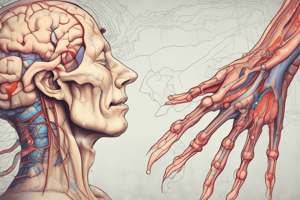Podcast
Questions and Answers
What is the main cause of oral papillomas?
What is the main cause of oral papillomas?
- Genodermatosis
- Traumatic neuroma
- HIV infection
- Human papillomavirus (HPV) (correct)
Which oral lesion is characterized by a haphazard proliferation of nerve bundles within fibrous connective tissue infiltrated with chronic inflammatory cells?
Which oral lesion is characterized by a haphazard proliferation of nerve bundles within fibrous connective tissue infiltrated with chronic inflammatory cells?
- Traumatic neuroma (correct)
- Verruca vulgaris
- Squamous cell papilloma
- Condyloma accuminatum
Which oral lesion is induced by human papillomavirus (HPV 6, 11)?
Which oral lesion is induced by human papillomavirus (HPV 6, 11)?
- Squamous cell papilloma (correct)
- Condyloma accuminatum
- Verruca vulgaris
- Multifocal epithelial hyperplasia (Heck’s disease)
What is the main clinical feature of squamous cell papilloma?
What is the main clinical feature of squamous cell papilloma?
What does verruca vulgaris histopathology show in terms of its epithelium?
What does verruca vulgaris histopathology show in terms of its epithelium?
Which condition is characterized by abnormal keratinization of oral mucosa due to defects in keratin 4 or keratin 13 genes?
Which condition is characterized by abnormal keratinization of oral mucosa due to defects in keratin 4 or keratin 13 genes?
What is the genetic disorder characterized mainly by hypertrophy of the nails and hyperkeratosis of the skin and mucosae?
What is the genetic disorder characterized mainly by hypertrophy of the nails and hyperkeratosis of the skin and mucosae?
Which of the following is NOT an example of etiologic factors for hyperplastic (reactive) lesions?
Which of the following is NOT an example of etiologic factors for hyperplastic (reactive) lesions?
What is the main difference between hyperplastic (reactive) and neoplastic lesions?
What is the main difference between hyperplastic (reactive) and neoplastic lesions?
Which of the following is a common cause of hyperplastic (reactive) lesions?
Which of the following is a common cause of hyperplastic (reactive) lesions?
What happens to hyperplastic (reactive) lesions once the causative stimulus is removed?
What happens to hyperplastic (reactive) lesions once the causative stimulus is removed?
What is the aim of the lecture on Oral Hyperplasia?
What is the aim of the lecture on Oral Hyperplasia?
Which of the following is a characteristic of neoplastic lesions?
Which of the following is a characteristic of neoplastic lesions?
What do hyperplastic (reactive) lesions show in relation to their growth and the stimulus?
What do hyperplastic (reactive) lesions show in relation to their growth and the stimulus?
Which of the following is NOT a tumor-like hyperplasia mentioned in the lecture?
Which of the following is NOT a tumor-like hyperplasia mentioned in the lecture?
What do neoplastic lesions usually do when the causative stimulus is removed?
What do neoplastic lesions usually do when the causative stimulus is removed?
Which lesion is characterized by excessive formation of highly vascularized fibrous connective tissue and is considered a vascular tumor?
Which lesion is characterized by excessive formation of highly vascularized fibrous connective tissue and is considered a vascular tumor?
Which lesion is most likely to show superficial erosion of underlying bone on radiographic examination?
Which lesion is most likely to show superficial erosion of underlying bone on radiographic examination?
Which condition is characterized by red edematous papillary projections on the hard palate and alveolar mucosa?
Which condition is characterized by red edematous papillary projections on the hard palate and alveolar mucosa?
Which lesion may develop initially as pyogenic granulomas that undergo fibrous maturation and subsequent calcification?
Which lesion may develop initially as pyogenic granulomas that undergo fibrous maturation and subsequent calcification?
Which lesion is a relatively common gingival growth and may be due to bone formation in a fibrous epulis?
Which lesion is a relatively common gingival growth and may be due to bone formation in a fibrous epulis?
Which condition is characterized by elongated rolls of tissue in the mucolabial or mucobuccal folds, and the flange of the denture fits in the fissure between folds?
Which condition is characterized by elongated rolls of tissue in the mucolabial or mucobuccal folds, and the flange of the denture fits in the fissure between folds?
Which lesion appears as numerous closely arranged red edematous papillary projections on the hard palate and alveolar mucosa?
Which lesion appears as numerous closely arranged red edematous papillary projections on the hard palate and alveolar mucosa?
Which lesion usually occurs on the hard palate beneath a maxillary denture, appears clinically as a pink flattened pedunculated mass, and resembles a leaf?
Which lesion usually occurs on the hard palate beneath a maxillary denture, appears clinically as a pink flattened pedunculated mass, and resembles a leaf?
Which of the following lesions is NOT characterized by a haphazard proliferation of nerve bundles within fibrous connective tissue infiltrated with chronic inflammatory cells?
Which of the following lesions is NOT characterized by a haphazard proliferation of nerve bundles within fibrous connective tissue infiltrated with chronic inflammatory cells?
What happens to hyperplastic (reactive) lesions once the causative stimulus is removed?
What happens to hyperplastic (reactive) lesions once the causative stimulus is removed?
What is the main difference between hyperplastic (reactive) and neoplastic lesions?
What is the main difference between hyperplastic (reactive) and neoplastic lesions?
Which of the following conditions is characterized by red edematous papillary projections on the hard palate and alveolar mucosa?
Which of the following conditions is characterized by red edematous papillary projections on the hard palate and alveolar mucosa?
Which condition is characterized by abnormal keratinization of oral mucosa due to defects in keratin 4 or keratin 13 genes?
Which condition is characterized by abnormal keratinization of oral mucosa due to defects in keratin 4 or keratin 13 genes?
What does verruca vulgaris histopathology show in terms of its epithelium?
What does verruca vulgaris histopathology show in terms of its epithelium?
Which of the following is a common cause of hyperplastic (reactive) lesions?
Which of the following is a common cause of hyperplastic (reactive) lesions?
Flashcards are hidden until you start studying




